Scania AB Bundle
How Does Scania AB Thrive in the Global Market?
Scania AB, a powerhouse in the heavy transport sector, is making waves with its commitment to sustainable solutions. As a leading Swedish truck manufacturer, Scania's innovations in electric and alternative fuel vehicles are reshaping the future of logistics. Understanding the inner workings of this industry giant is key to grasping its impact.
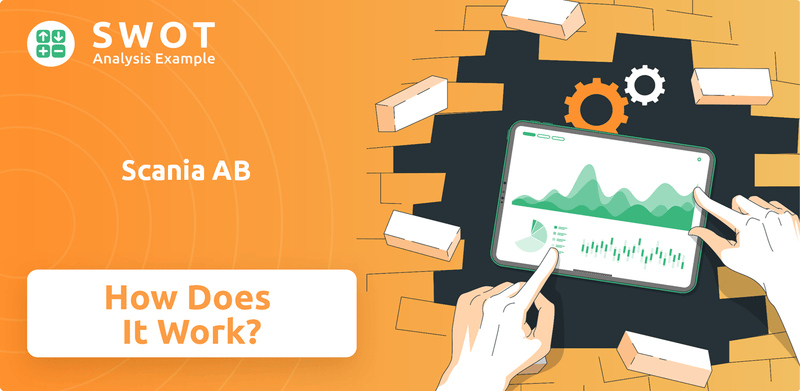
This exploration into Scania's operations will reveal the secrets behind its success, from its advanced manufacturing processes to its strategic financial services. We'll delve into the Scania AB SWOT Analysis to examine its strengths, weaknesses, opportunities, and threats, providing a comprehensive view of its market position. Discover how this global leader leverages its Scania trucks, buses, and engines to maintain its competitive edge and drive profitability, exploring aspects like Scania's business model, Scania operations, and its impressive Scania AB financial performance.
What Are the Key Operations Driving Scania AB’s Success?
Scania AB, a prominent Swedish truck manufacturer, operates by integrating manufacturing and service offerings for heavy trucks, buses, and engines. The Scania company focuses on providing solutions for various customer segments, including logistics firms and public transport operators. Their core products include heavy-duty trucks, city and intercity buses, and industrial and marine engines, showcasing a diverse product portfolio.
The Scania business model is centered around a modular product system, enabling high customization and efficient production. This approach allows Scania trucks to meet specific customer needs while maintaining operational efficiency. This flexibility is a key differentiator in the competitive market, driving customer satisfaction and loyalty.
Scania operations encompass advanced manufacturing, rigorous component sourcing, and a sophisticated global logistics network. The company emphasizes lean manufacturing principles to ensure high quality and efficiency. Strategic partnerships and in-house research and development, particularly in electrification and autonomous driving, further enhance its capabilities.
Scania offers a wide array of heavy-duty trucks for long-haulage, construction, and distribution. The product line also includes city and intercity buses, and industrial and marine engines. This diverse range caters to various customer needs and applications.
Scania utilizes advanced manufacturing facilities and lean production principles. Production units are located in Europe and Latin America, supported by a global supply chain. This ensures high-quality products and efficient processes.
Beyond vehicle sales, Scania provides comprehensive financial services through Scania Financial Services. This includes financing, leasing, and insurance solutions. The company also offers extensive service contracts and connected services.
Customers benefit from improved fuel efficiency, increased uptime, and lower operating costs. Scania’s integrated approach, combining advanced products with robust support services, enhances customer value and satisfaction.
Scania AB focuses on several key operational aspects to maintain its competitive edge. These include a global supply chain, continuous technology development, and strategic partnerships. The company's emphasis on sustainability and innovation further strengthens its market position.
- Global Supply Chain: Production units in Europe and Latin America supported by a network of independent importers and dealers.
- Technology Development: Strong focus on in-house research and development, particularly in electrification and autonomous driving.
- Financial Services: Offers comprehensive financial services, including financing, leasing, and insurance solutions.
- Connected Services: Provides connected services to optimize vehicle uptime and performance.
Scania AB SWOT Analysis
- Complete SWOT Breakdown
- Fully Customizable
- Editable in Excel & Word
- Professional Formatting
- Investor-Ready Format
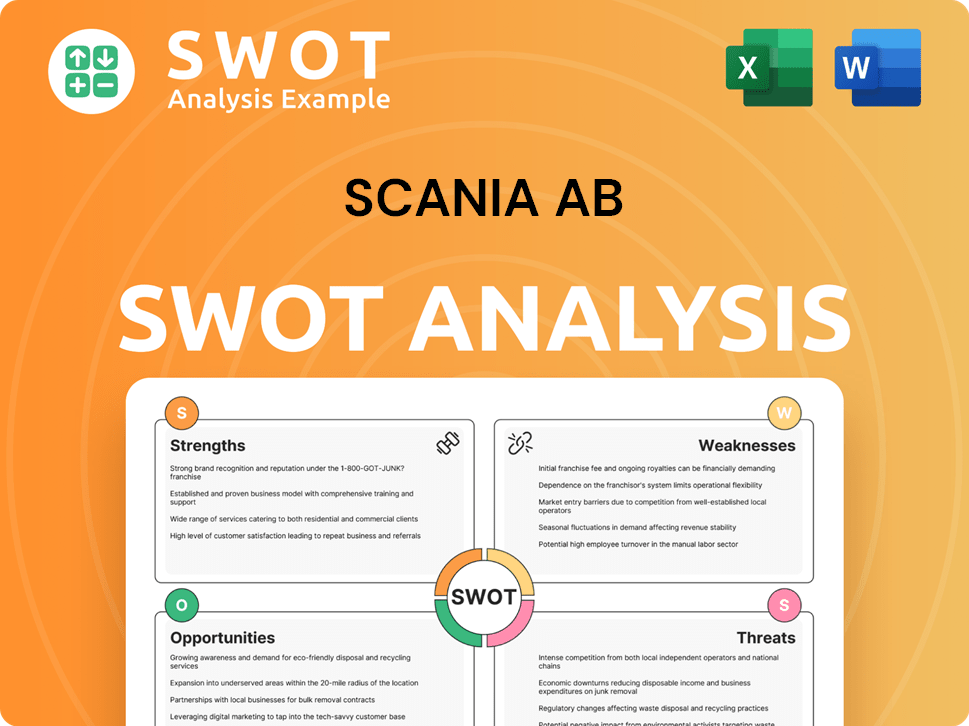
How Does Scania AB Make Money?
Scania AB, a prominent Swedish truck manufacturer, employs a diversified revenue model centered on vehicle sales, service offerings, and financial services. This strategic approach allows the company to capture value throughout the lifecycle of its products and services, ensuring sustained profitability and customer loyalty. The company's financial performance in recent years reflects the effectiveness of these strategies, demonstrating robust growth and resilience in a competitive market.
The company's revenue streams are primarily categorized into vehicle sales, service-related income, and financial services. Vehicle sales, including heavy trucks and buses, form the largest part of Scania's revenue. Service-related income, which includes maintenance contracts and spare parts sales, provides a recurring revenue stream. Scania Financial Services offers tailored financing, leasing, and insurance solutions to customers, further diversifying monetization strategies.
In 2023, Scania AB reported net sales of SEK 204.7 billion, marking a 28% increase compared to the previous year. This growth was driven by strong demand for its core products, with truck deliveries reaching 96,726 units and bus deliveries reaching 7,540 units. The service business also saw an 11% increase in volume during the same period, highlighting the importance of after-sales support. Furthermore, the financial services segment contributed significantly, with an operating income of SEK 2,342 million in 2023.
Scania AB maximizes revenue through a combination of strategic initiatives. This approach includes tiered pricing, bundling solutions, and cross-selling financial services with vehicle purchases. The company's focus on sustainable transport solutions, with an increasing share of electric and alternative fuel vehicles, aligns with market trends and regulatory pressures. For more details on Scania's strategic growth, you can refer to this article about Growth Strategy of Scania AB.
- Vehicle Sales: Heavy trucks, buses, and engines contribute the most to revenue.
- Service-Related Income: Maintenance, spare parts, and connected services generate recurring revenue.
- Financial Services: Financing, leasing, and insurance support vehicle sales and generate additional income.
- Tiered Pricing and Bundling: Strategies to maximize revenue per customer.
- Sustainable Solutions: Focus on electric and alternative fuel vehicles to meet market demands.
Scania AB PESTLE Analysis
- Covers All 6 PESTLE Categories
- No Research Needed – Save Hours of Work
- Built by Experts, Trusted by Consultants
- Instant Download, Ready to Use
- 100% Editable, Fully Customizable
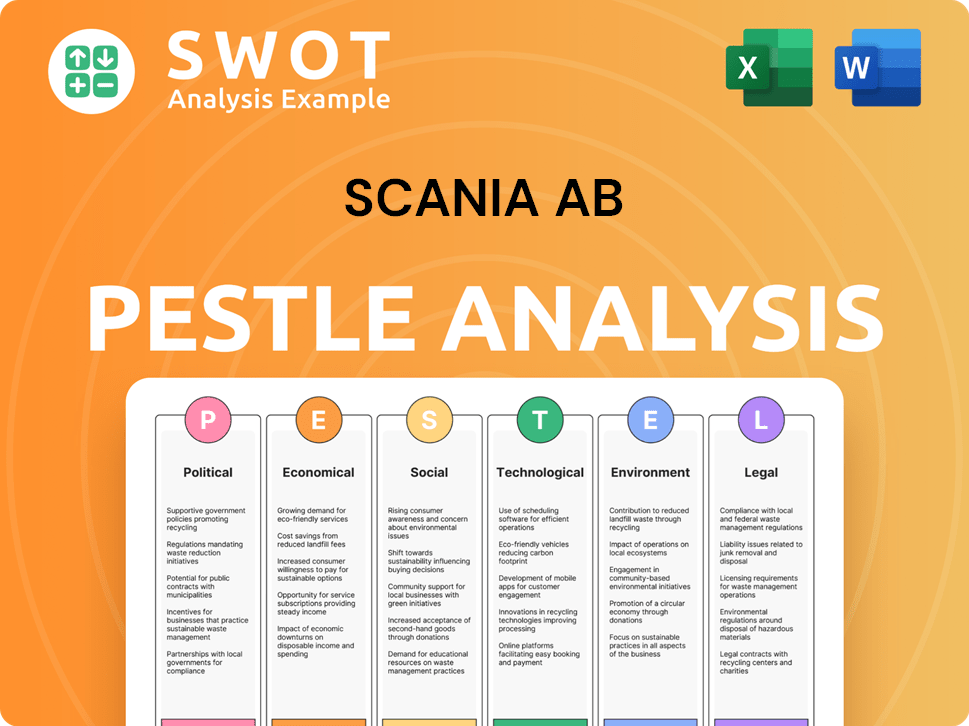
Which Strategic Decisions Have Shaped Scania AB’s Business Model?
The journey of Scania AB has been marked by significant milestones and strategic shifts, profoundly influencing its operations and financial outcomes. A crucial ongoing strategic move is the company's accelerated transition towards electrification and sustainable transport solutions. This involves substantial investments in developing battery electric vehicles (BEVs) and fuel cell electric vehicles (FCEVs), alongside expanding charging infrastructure partnerships. This strategic pivot addresses both environmental concerns and evolving regulatory landscapes, positioning Scania AB for future growth.
Scania has faced operational challenges, including supply chain disruptions, particularly during recent global events. Despite these hurdles, the company has demonstrated resilience, as evidenced by its robust production and delivery figures. For instance, despite a challenging start to the year due to component shortages, Scania managed to increase its vehicle deliveries significantly. This resilience is a testament to Scania's robust operational strategies and adaptability.
Scania's competitive advantages are multifaceted. Its strong brand reputation, built on reliability, fuel efficiency, and robust engineering, provides a significant edge. The modular product system offers unparalleled flexibility and customization, allowing Scania to efficiently meet diverse customer needs while benefiting from economies of scale in manufacturing. Furthermore, Scania's comprehensive service network and integrated financial services create a powerful ecosystem that enhances customer loyalty and provides recurring revenue streams.
Scania's history is marked by key technological advancements and strategic acquisitions. Early milestones include pioneering diesel engine technology and expanding into global markets. More recently, the focus has shifted towards sustainable transport solutions and digital services. These moves have solidified Scania's position as a leader in the transport industry.
The company's strategic moves include a strong emphasis on electrification, digital services, and expanding its service network. Investments in research and development are crucial for innovation. Partnerships with technology providers and infrastructure developers are also key. These moves are aimed at future-proofing Scania's business model.
Scania benefits from a strong brand reputation and a customer-centric approach. Its modular product system offers flexibility and efficiency. A comprehensive service network and financial services create customer loyalty. These advantages enable Scania to maintain a strong market position.
Scania AB consistently demonstrates solid financial performance. In 2023, despite facing supply chain challenges, Scania reported increased vehicle deliveries. The company's focus on profitability and efficiency has driven its financial success. For more details, you can explore the insights provided by Owners & Shareholders of Scania AB.
Scania's competitive edge stems from several factors, including a strong brand reputation and a modular product system. Its extensive service network and integrated financial services also contribute significantly. The company's commitment to sustainability and innovation in electric and alternative fuel technologies further enhances its competitive position.
- Strong Brand Reputation: Built on reliability, fuel efficiency, and robust engineering.
- Modular Product System: Offers unparalleled flexibility and customization.
- Comprehensive Service Network: Enhances customer loyalty and provides recurring revenue.
- Sustainability Initiatives: Investments in electric and alternative fuel technologies.
Scania AB Business Model Canvas
- Complete 9-Block Business Model Canvas
- Effortlessly Communicate Your Business Strategy
- Investor-Ready BMC Format
- 100% Editable and Customizable
- Clear and Structured Layout
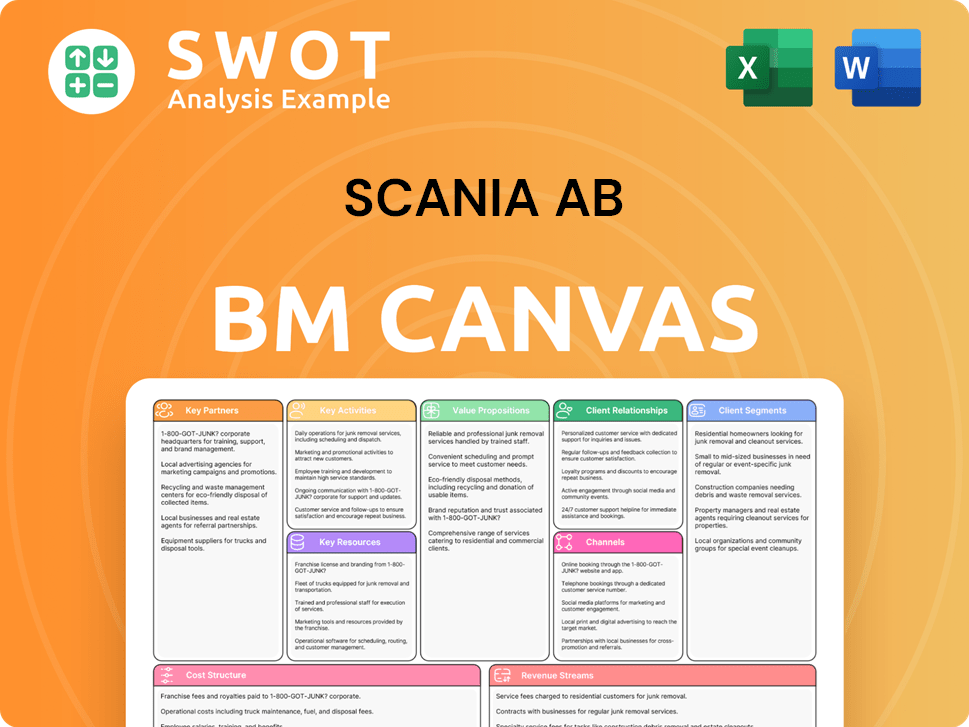
How Is Scania AB Positioning Itself for Continued Success?
The Scania AB, a Swedish truck manufacturer, holds a strong position in the global heavy truck and bus industry. It competes with major players like Volvo and Daimler Truck. The company has a significant market share in Europe and Latin America, known for its premium quality, fuel efficiency, and after-sales support. Scania trucks are recognized for their total operating economy, which drives high customer loyalty.
Scania company faces risks such as changing emissions regulations and intense competition, particularly in electric vehicles. Economic downturns and geopolitical instability also impact demand and supply chains. Technological advancements in autonomous driving and connectivity require continuous investment. For a deeper understanding of its market focus, consider the Target Market of Scania AB.
Scania AB maintains a significant market share in Europe and Latin America. The company's reputation for quality and fuel efficiency supports its strong position. Its focus on sustainable transport solutions, including electric vehicles, is increasing.
Regulatory changes concerning emissions and safety impact product development. Intense competition from emerging markets and EV technology poses a threat. Economic downturns and supply chain disruptions can affect demand.
Scania aims to accelerate electrification with ambitious EV sales targets. The company is expanding its charging infrastructure and digital services. It plans to sustain profitability by leveraging its modular product system.
Expanding charging infrastructure and developing new digital services are key. Optimizing the global production footprint is also a priority. The company is leading the transition to a fossil-free transport system.
Scania AB is heavily invested in sustainable transport solutions, particularly electrification. The company has set ambitious goals for electric vehicle sales. Scania aims to reduce its environmental impact while delivering customer value.
- Increased focus on electric trucks and buses.
- Expansion of charging infrastructure.
- Development of digital and connected services.
- Optimizing global production for sustainability.
Scania AB Porter's Five Forces Analysis
- Covers All 5 Competitive Forces in Detail
- Structured for Consultants, Students, and Founders
- 100% Editable in Microsoft Word & Excel
- Instant Digital Download – Use Immediately
- Compatible with Mac & PC – Fully Unlocked
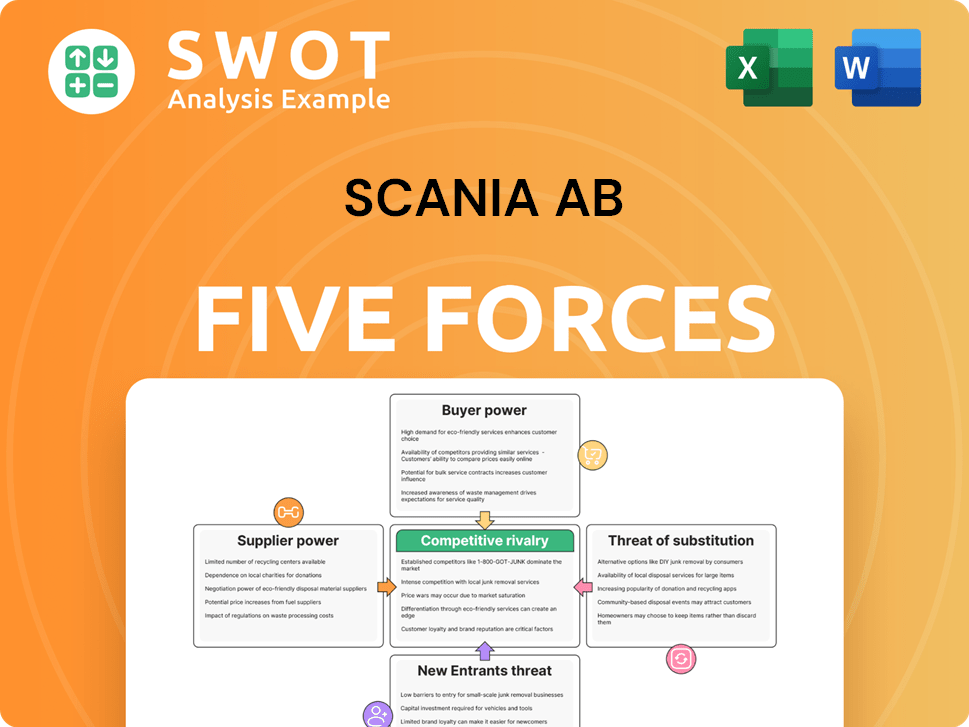
Related Blogs
- What are Mission Vision & Core Values of Scania AB Company?
- What is Competitive Landscape of Scania AB Company?
- What is Growth Strategy and Future Prospects of Scania AB Company?
- What is Sales and Marketing Strategy of Scania AB Company?
- What is Brief History of Scania AB Company?
- Who Owns Scania AB Company?
- What is Customer Demographics and Target Market of Scania AB Company?
Disclaimer
All information, articles, and product details provided on this website are for general informational and educational purposes only. We do not claim any ownership over, nor do we intend to infringe upon, any trademarks, copyrights, logos, brand names, or other intellectual property mentioned or depicted on this site. Such intellectual property remains the property of its respective owners, and any references here are made solely for identification or informational purposes, without implying any affiliation, endorsement, or partnership.
We make no representations or warranties, express or implied, regarding the accuracy, completeness, or suitability of any content or products presented. Nothing on this website should be construed as legal, tax, investment, financial, medical, or other professional advice. In addition, no part of this site—including articles or product references—constitutes a solicitation, recommendation, endorsement, advertisement, or offer to buy or sell any securities, franchises, or other financial instruments, particularly in jurisdictions where such activity would be unlawful.
All content is of a general nature and may not address the specific circumstances of any individual or entity. It is not a substitute for professional advice or services. Any actions you take based on the information provided here are strictly at your own risk. You accept full responsibility for any decisions or outcomes arising from your use of this website and agree to release us from any liability in connection with your use of, or reliance upon, the content or products found herein.